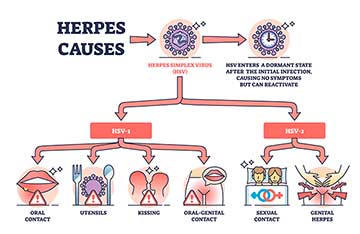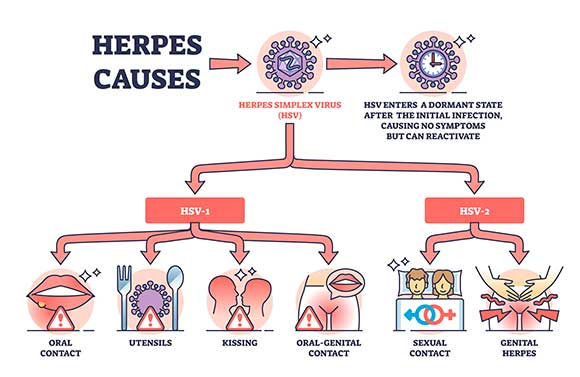How common is herpes 1 vs herpes 2?
Herpes 1 is more common than herpes 2. [1] Prevalence of Herpes Simplex Virus Type 1 and Type 2 in Persons Aged 14–49: United States, 2015–2016 https://www.cdc.gov/nchs/data/databriefs/db304.pdf
48.1% of people have herpes 1 vs 11.9 % for herpes 2. [3] Trends in herpes simplex virus type 1 and type 2 seroprevalence in the United States https://pubmed.ncbi.nlm.nih.gov/16926356/
The prevalence of both herpes types increases with age.
The Herpes 1 rate is declining over time (by more than 10% over the last 50 years) while herpes 2 is increasing by more than 60% [2] Increasing role of herpes simplex virus type 1 in first-episode anogenital herpes in heterosexual women and younger men who have sex with men, 1992-2006 https://pubmed.ncbi.nlm.nih.gov/19273479/

Virus acquisition age difference for HSV-1 vs2
People usually get HSV-1 during their childhood from friends and parents through nonsexual transmission. In contrast, HSV-2 is mainly transmitted after 14 years of age, and for that reason, it carries the stigma of being an STD. But both viruses can be acquired at any age.
How do you get Herpes 1 vs 2?
Both herpes 1 and two transmitted via skin-to-skin contact. Since most HSV-2 occurs genitally, it is transmitted via intimate genitalskin contact and, for that reason, is considered an STD. HSV-1 is mainly transmitted in a nonsexual way (kissing) from parents, siblings, and friends.
Both conditions are rarely transmitted via toilet seats and household utensils.
Areas affected by herpes 1 vs 2
HSV-1 primarily affects the oral region. HSV-2 mainly affects the genital area. Why? Two reasons:
✓ The outer portion of two different herpes virus types has slightly different proteins they use to enter the cell. HSV-1 protein molecules are better at attaching to the kinds of cells that occur around the mouth, while HSV 2 is better for cells that occur around the genitals and anus.
✓ During latency (when no symptoms are seen), the herpes virus lives (stays suppressed by the immune system) in the collection of nerve cells called ganglia. So, HSV-1 prefers to be embedded in the trigeminal ganglia, and HSV-2 prefers sacral ganglia.
However, both virus types may affect either the oral or genital area.
Again:
✓ HSV-1 primarily affects the oral area.
✓ HSV-2 primarily affects the genital area (58.7% of genital herpes cases). [4] Seroprevalence of herpes simplex virus types 1 and 2--United States, 1999-2010 https://pubmed.ncbi.nlm.nih.gov/24136792/
✓ HSV-1 affects the genital area in up to 41.3% of cases caused by oral-to-genital sex.
✓ HSV-2 can cause oral herpes, but this does not happen as often as HSV-1 affects the genital area. [5] HSV-2 incidence by sex over four age periods to age 38 in a birth cohort https://pubmed.ncbi.nlm.nih.gov/24337730/
How infectious is herpes virus 1 compared to herpes virus 2?
HSV-2 is slightly easier to pass than HSV-1. That is, it is somewhat more contagious.
The transmission can occur with the outbreak and while asymptomatic.
The transmission rate for both virus types with symptoms (visible sores, blisters, and crust) is the same, but HSV-2's silent (without symptoms) transmission is higher.
According to the CDC, this happens because asymptomatic virus shedding occurs more often and for longer with herpes 2 virus than with herpes 1.
Outbreak recurrence for HSV-2 vs HSV-1
Both herpes virus types tend to reoccur, but the recurrence rate differs for both viruses.
HSV 2 virus reoccurs more often (up to 12 times a year), while HSV 1 can have one outbreak with no recurrences.
The chance of recurrence for HSV-2 is 33% a month, and for HSV-1 is 2%
The recurrence rate decreases over time for both virus types.
Outbreak severity for herpes 1 vs herpes 2
In addition to being more frequent, the outbreak is more substantial (more sores and blisters) and lasts longer for HSV-2 than HSV-1.
The outbreak severity decreases over time for both virus types.
Outbreak appearance, testing, and treatment.
The outbreak appearance, testing, and treatment are identical for both herpes types.
FAQ
Can HSV1 turn into 2 and vice versa? ›
Is it essential to know the difference between the symptoms of herpes types 1 and 2? ›
Source
-
Prevalence of Herpes Simplex Virus Type 1 and Type 2 in Persons Aged 14–49: United States, 2015–2016
https://www.cdc.gov/nchs/data/databriefs/db304.pdf -
Increasing role of herpes simplex virus type 1 in first-episode anogenital herpes in heterosexual women and younger men who have sex with men, 1992-2006
https://pubmed.ncbi.nlm.nih.gov/19273479/ -
Trends in herpes simplex virus type 1 and type 2 seroprevalence in the United States
https://pubmed.ncbi.nlm.nih.gov/16926356/ -
Seroprevalence of herpes simplex virus types 1 and 2--United States, 1999-2010
https://pubmed.ncbi.nlm.nih.gov/24136792/ -
HSV-2 incidence by sex over four age periods to age 38 in a birth cohort
https://pubmed.ncbi.nlm.nih.gov/24337730/
